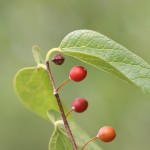Sugar Hackberry, Texas Sugarberry, Southern Hackberry
Celtis laevigata Willd.
Ulmaceae (Elm family)
Description
Hackberry species occur throughout Texas; five species are trees, and one is shrublike. The two species most common across the state are Celtis laevigata, also called "Sugarberry" or "Sugar Hackberry," and C. laevigata, var. reticulate, most commonly known as "Netleaf Hackberry" or "Western Hackberry." The Sugarberry trees have strong tap roots and many shallow, spreading roots. The bark is primarily smooth and gray, with small bumps or warts on the older stems. The wood has a characteristic yellowish-white color. The leaves of Hackberry have a rough texture, like sandpaper. They are alternate and simple, usually with smooth edges. The leaves are 2-4 inches long and 1 to 2 inches wide and gradually taper to a point that is curved. The leaf underside has large, netlike veins. Although not noticeable, the flowers occur in early spring and develop into rounded, succulent, reddish brown to black fruits (drupes) that persist on the tree throughout the winter. The forage value is fair for wildlife, primarily birds, and poor for livestock.Habitat
Sugarberry is native to Texas and grows in rocky draws, arroyos, and other low areas receiving adequate moisture. It can also grow in thickets, open woodlands, and along streams and riverbanks.Images
Plant Characteristics
Flower Color: Green
Seed Type: Fruit/Berry
Duration: Perennial
Stem Texture: Hairless/Smooth
Growth Habit: Tree
Leaf Shape
 : Simple with Pinnate or Parallel Venation
: Simple with Pinnate or Parallel Venation
Season: Warm
Distribution
 : 01 - Pineywoods, 02 - Gulf Prairies and Marshes, 03 - Post Oak Savannah, 04 - Blackland Prairies, 05 - Cross Timbers and Prairies, 06 - South Texas Plains, 07 - Edwards Plateau, 08 - Rolling Plains, 09 - High Plains, 10 - Trans-Pecos
: 01 - Pineywoods, 02 - Gulf Prairies and Marshes, 03 - Post Oak Savannah, 04 - Blackland Prairies, 05 - Cross Timbers and Prairies, 06 - South Texas Plains, 07 - Edwards Plateau, 08 - Rolling Plains, 09 - High Plains, 10 - Trans-Pecos
Distributions
Distribution refers to the ecological region in Texas that a plant has been found. You can also view a clickable map.
Collection: Brush and Weeds







